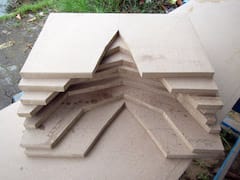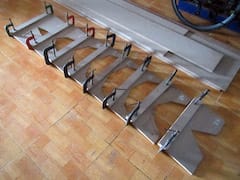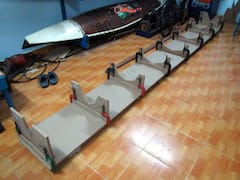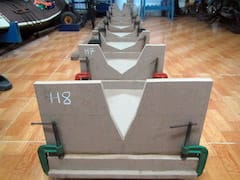 ontinue working on the new deck! The deck has 3 bulkheads of its own, corresponding to those of the hull. The two rudder control lines would run inside plastic tubes, which run through these bulkheads via waterproof cable glands. But that would be later, first is installing the cockpit coaming, which is just a thin plywood strip bending around a MDF frame. The coaming lip is also cut from plywood.
ontinue working on the new deck! The deck has 3 bulkheads of its own, corresponding to those of the hull. The two rudder control lines would run inside plastic tubes, which run through these bulkheads via waterproof cable glands. But that would be later, first is installing the cockpit coaming, which is just a thin plywood strip bending around a MDF frame. The coaming lip is also cut from plywood.
First image: you can see my beloved Fein Multi Master, the renown oscillating tool. Often when I have to cut or do other tasks in tight corners or in positions that are inaccessible or inconvenient to other reciprocal tools, this Fein is my last resort, and it’s always been very helpful to me. Here, I need to trim the already installed, but wrongly – sized bulkheads. Also, really love the tool’s Germany quality.
There’re some other tasks which are not reflected in the images here: fairing the hull and deck’s external seams, then glassing them with my fiber tapes. It’s not until now that I could comprehensively master the skills working with epoxy and glassing, using just the right amount of them. But also, I also gave up the idea of a kayak that’s as light as possible. For a training, exercising boat, lighter is of course better.
E.g: 15 vs 20 kg is a huge different, cause it’s much easier to launch and retrieve the (almost empty) boat for every training sessions. But for an expedition boats, a few kilograms doesn’t make much difference, since a loaded kayak weighs as much as 110 ~ 120 kg, with that mass, you can’t carry on your back anyhow, so a few more kilograms added would worth the value of a stiffer, more durable boat prepared for long journeys!

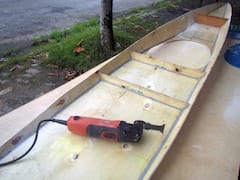
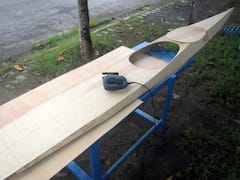
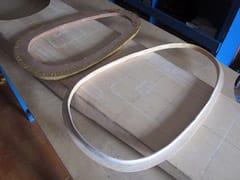
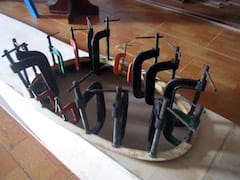
 major setback in the building progress, the curved deck didn’t come out with my expected quality. After released from the molding frame, the deck slowly bend back from its curved shape, especially amid of the boat, off from the desired geometry by 3, 4 cm (first image). That’s really bad… 😢😢 I made a hard decision to discard the rounded deck, and build a hard – chined one (like my previous kayak) instead!
major setback in the building progress, the curved deck didn’t come out with my expected quality. After released from the molding frame, the deck slowly bend back from its curved shape, especially amid of the boat, off from the desired geometry by 3, 4 cm (first image). That’s really bad… 😢😢 I made a hard decision to discard the rounded deck, and build a hard – chined one (like my previous kayak) instead!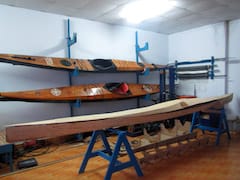
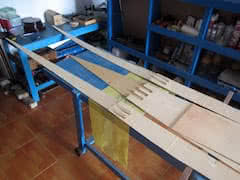
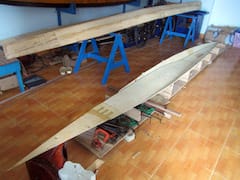
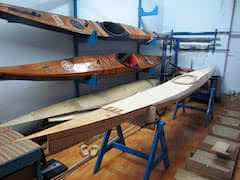
 ith my Dremel – Multi – 3000 tool, I made lots of parallel cuts onto the deck internal side (see the first image), the cuts are about 1.5 cm apart, and about 1 ~ 1.5 mm deep. Those are not very deep cut, since the plywood is only 4 mm (3.75 mm to be exact). Then I soak the deck with water thoroughly, for the ply to be softened, then put it into the frame and press it down… with my body weight (just sit on it) 😀.
ith my Dremel – Multi – 3000 tool, I made lots of parallel cuts onto the deck internal side (see the first image), the cuts are about 1.5 cm apart, and about 1 ~ 1.5 mm deep. Those are not very deep cut, since the plywood is only 4 mm (3.75 mm to be exact). Then I soak the deck with water thoroughly, for the ply to be softened, then put it into the frame and press it down… with my body weight (just sit on it) 😀.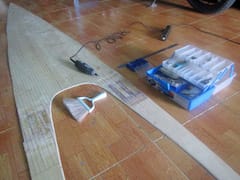
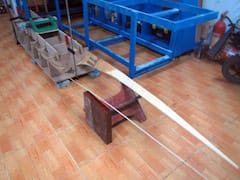
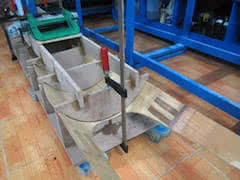
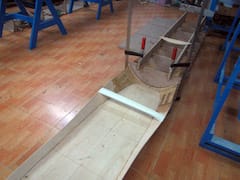
 irst image: the basically completed hull, put aside, now working on the deck part. Compared to the hull, which is… simpler and more well defined in term of geometrical shape, the deck is just loosely draft out in overall shape, it’s cut slightly over size, so that when fitted together with the hull, it would be trimmed to match. The construction is also more complex, due to the rounded shape of the forward part.
irst image: the basically completed hull, put aside, now working on the deck part. Compared to the hull, which is… simpler and more well defined in term of geometrical shape, the deck is just loosely draft out in overall shape, it’s cut slightly over size, so that when fitted together with the hull, it would be trimmed to match. The construction is also more complex, due to the rounded shape of the forward part.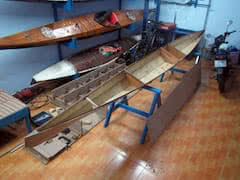
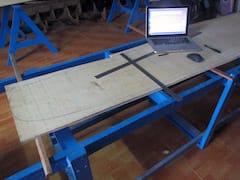
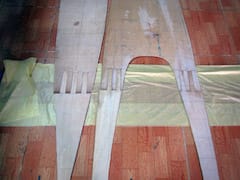
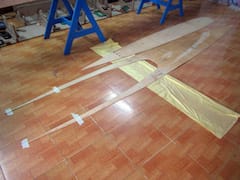
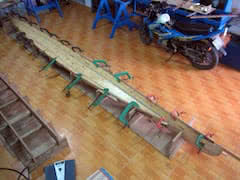
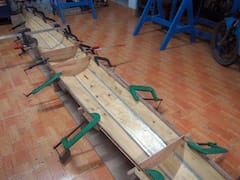
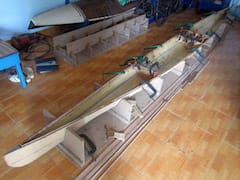
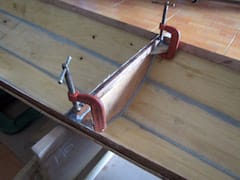

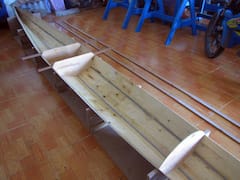
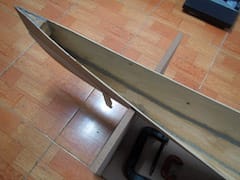
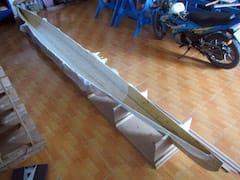
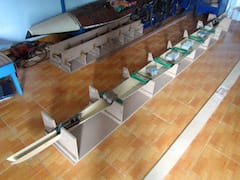
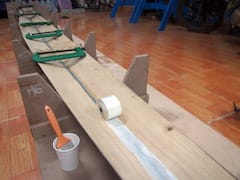
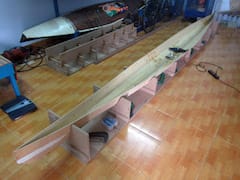
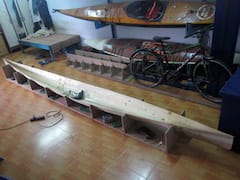
 roceed to cutting and jointing the bilges. This step is done quite quickly as I’ve now had plenty of experiences 😀. I read the offset – table directly from the FreeShip software, then draw the bilges on the 122 x 244 – cm plywood sheet. For the 17 feet hull, there’re 3 pieces per bilges, and hence, 2 joints need to be made for each bilges. I clamp 2 plywood sheets together and cut the port & starboard parts at the same time.
roceed to cutting and jointing the bilges. This step is done quite quickly as I’ve now had plenty of experiences 😀. I read the offset – table directly from the FreeShip software, then draw the bilges on the 122 x 244 – cm plywood sheet. For the 17 feet hull, there’re 3 pieces per bilges, and hence, 2 joints need to be made for each bilges. I clamp 2 plywood sheets together and cut the port & starboard parts at the same time.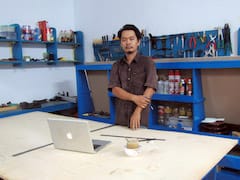
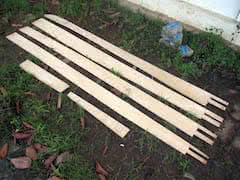
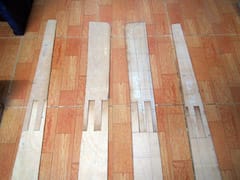
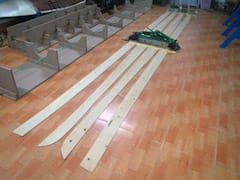
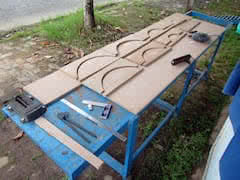
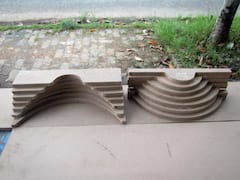
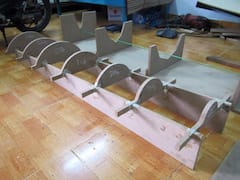
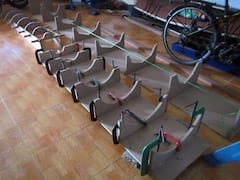
 imple thing that is done many times already, since the very first time I was building the
imple thing that is done many times already, since the very first time I was building the 